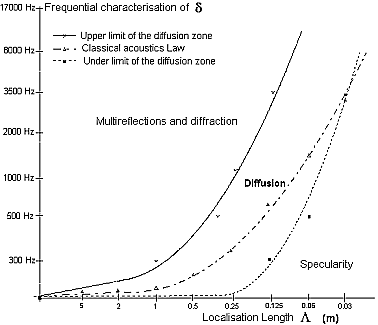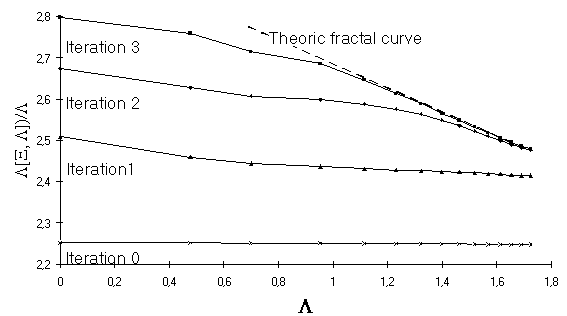The diffusion volume of a fractal structure
The diffusion volume is reducible to real convex isotropic
Euclidean (non-fractal) structures, as polygons (for which it describes the real
surface) and convex polyhedrons (for which it describes the effective volume). For
all other cases where the structure presents a limit complexity, the diffusion volume describes
the diffusion level of the structure, characterised with its topologic dimension d
and its fractal dimension D.
Knowing that the volume V and the surface S of an
Euclidean structure are defined with both quadratic and cubic relationships to the
perimeter P with : S = Fq P et V = Fc P3, the
geometrical nature of the entity is readable in the value of the prefactor in those
relationships, the shape factors Fq and Fc.
Extending this expression to the structure's generalised volume Vx,
those perimetric equations become, in the Euclidean system, Vx = Fx Pxd, or, for a D-dimensional fractal structure, Vx = Fx
PxD.
The prefactor Fx defines uniquely the global shape of the
structure, Euclidean or fractal. The local shape complexity we quantify depends
only on the perimeter power factor D, readable in the slope of the shape spectrum FD = d - D, which was estimated with the Minkowski
recovering method, as shown previously.
For this Minkowski analysis of a continuous self-similar structure,
such as the Sierpinski profile we saw before, the inferior and superior volumic measures
of the structure converge to an eigenvalue involving simultaneously its local and
global measures. This constitutes the measure of the diffusion volume of the
structure. Its principle shows a dependence between the diffusion volume and both fractal
and Euclidean dimensions D and d of the structure.
Frequency and diffusion coefficient
At the scale e, the specular limit of the acoustic propagation
phenomena is expressed with the limit frequency fe, which wavelength
le = c / fe
corresponds to the lowest propagation mode, for the corresponding roughness of the
structure, estimated with the localisation length L.
In this way, L represents the greatest
distance for which the surface characterization is negligible compared to the wavelength
le.
Thus, the diffusion coefficient d is
defined with its diffusive under-limit frequency fe,
at the localization length L.

Frequency characterisation of the diffusion coefficient d, versus localization length L
For acoustic modes at frequencies greater than the wavelength le, acoustical propagation
remains specular in the structure, which is classed as rigid for those frequencies :
there is no diffusion.
Perspectives
The symmetry that appears between the number of reflections in a
fractal structure and its localization length L allows us to
reconsider the classical acoustic energy conservation laws.
The diffusion phenomenon model in a room considered as a self-similar
network presents an important analogy with non ergodic structures, where preferred
specular reflections directions do not allow an isotropic diffusion phenomenon.
Therefore, an urban street, assimilated to a one-sided open room,
confirms this non-ergodicity, as the mean free path cannot be defined in that
configuration. So it is possible to find specific diffusion modes, considering a typical
energy behaviour in non-linear complex structures which exponent depends on the hyperbolic
distribution process of the intermissions, the Levy flights.
Those flights are considered as infinite excursions, and the
computation of their homothetic return probability allows us to parametrize their
persistence, after have being " trapped " in the structure.

Three Levy flights, getting more and more persistent, from over-
to under-diffusion
Those new acoustic hypothesis leads us to define another type of
reverberation " over- ", or
" under-diffusive ", depending on the fractal dimension D of the
structure. Therefore, it would be necessary to define another energetic decreasing law,
which would remain exponential: those perspectives constitute the next step of our
research work.
References
- D'Antonio P. : " Fractals and number theory ara changing the shape of
acoustics ", Sound and Vibration, October 1992.
- Frankhauser P., Sadler R. : " Fractal Analysis of
Agglomerations ", in Sonderforschungsbereich 230 "Natrliche
Konstruktionen", d. Natural Structures - Principles, Strategies and
Models in Architecture and Nature, Vol.2, 1992.
- Kuttruff H. : " A mathematical model for noise propagation between
buildings ", J.Sound Vib. 85, 1982, pp.115-128.
- Mandelbrot B. : " Les objets fractals ", Paris, Flammarion,
1992.
- Woloszyn P., Raymond F., Picaut J. : " Morphological parametering of a
diffusive acoustic model for complex urban areas ", in : Wesprac'97 6th Western
Pacific regional acoustic conference, Hong-Kong, 19-21 novembre 1997. Hong Kong Institute
of Acoustics, 1997, pp. 231-236
- Woloszyn P. : " Caractrisation dimensionnelle de la diffusivit des formes
architecturales urbaines ". Thse de doctorat de l'Universit de Nantes. 1998.
260 p.
[ Lay Language Paper Index | Press Room ]




